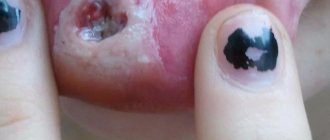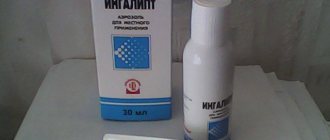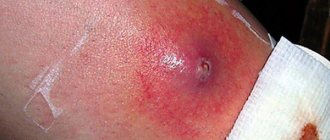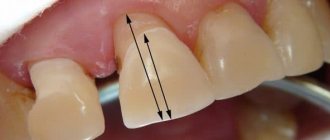Reasons for the development of flux
Flux on the gums has certain causes that need to be established before starting treatment at home.
So, the tumor is provoked by the following factors:
- mechanical damage to the gums;
- untreated tooth;
- inflammation of the gum pocket;
- advanced caries;
- pulpitis;
- periodontitis in acute form.
Important!
Some of the above reasons are not something you can identify on your own. So make an appointment with your dentist.
Comments
I got gumboil from my wisdom tooth. I don’t want to go to the doctor, because he’ll definitely tell me to remove it?
Andrey (09/02/2020 at 01:23 pm) Reply to comment
- Dear Andrey, you need to take an x-ray to understand how to proceed. If the wisdom tooth grows without disturbances, has passable root canals, and its crown part is not too damaged, then treatment is possible. The main thing here is not to delay seeing a doctor. If the verdict is the removal of such a tooth, then we must remember that it is much more dangerous not to remove it (osteomyelitis may occur), and be prepared for the operation, because there is nothing terrible in it. Today, even the most complex manipulations are carried out under very high-quality anesthesia and do not cause pain, and if the doctor’s recommendations are followed, damaged tissues heal normally and without complications.
Editorial staff of the portal UltraSmile.ru (09/05/2020 at 09:07) Reply to comment
Tell me if there is an abscess on the gum, but it is not painful and it is clear that it will rupture soon. I'm not taking any action yet. Do I need to go to the doctor? Is it possible to just apply something and then rinse out the pus?
Ivan Petrovich (09.23.2020 at 09:09) Reply to comment
Please tell me, my husband’s gumboil has popped up on several of his teeth many times over a long period of time (2 years). He doesn’t want to go to any doctor. Should he have all these teeth removed or is there a chance to save them?
Anastasia (09.23.2020 at 09:32) Reply to comment
Tell me, please, is there a connection between the exacerbation of chronic sinusitis in the autumn and the appearance of gumboil on the upper tooth at the same time? The fact that the upper “fours” are very weak and already filled and there is a pin in one - I think that sinusitis is also to blame. What about flux?
Vitaly (09/23/2020 at 12:53 pm) Reply to comment
Write your comment Cancel reply
No. 1. Antibiotics for flux
You should not prescribe yourself a course of antibiotics. But if you decide to do this, then study the section with contraindications and subtleties of administration.
"Amoxicillin"
Flux is accompanied by inflammation and the development of pus (not always). How to remove a tumor - take Amoxicillin at home. It quickly suppresses the activity of pathogenic microorganisms, the swelling subsides after a few days. When positive dynamics are achieved, you need to urgently go to the doctor.
"Lincomycin"
The most powerful bactericidal effect is aimed at the focus of the inflammatory process. Thanks to this, it is possible to achieve results much faster than when taking Amoxicillin. When the swelling subsides, you should not stop therapy for a few more days.
"Tsifran"
Dental gumboil is determined by the degree of neglect. In difficult cases, treatment at home is carried out with antibiotics administered by injection. The medicinal composition is very strong, and accordingly, it is released only as prescribed by a doctor.
"Ampioks"
Combined antibiotic including ampicillin. The substances stop the further spread of swelling, relieve severe pain, and kill pathogenic bacteria. There are minimal contraindications, but they should be taken into account.
"Doxycycline"
Flux needs to be treated urgently. But before removing the tumor, it is advisable to obtain a doctor’s approval for the use of Doxycycline at home. When used skillfully, the drug will quickly kill pathogens and remove swelling.
Treatment with antibiotics
Antibiotics are prescribed to stop the infection from progressing. They are also mandatory after surgical treatment and tooth extraction. In severe cases, a home solution will not be effective. For periostitis, the following antibiotics are prescribed:
Lincomycin is widely used for infectious and bacterial diseases of the oral cavity. Do not take if you have liver or kidney diseases.
Amoxiclav - actively acts against pathogenic microorganisms that cause inflammation in the oral cavity. Can only be taken as prescribed by a doctor.
Antibiotics are prescribed by the doctor, taking into account the characteristics of the disease in each patient. It is forbidden to take them on your own, as they have a large number of contraindications.
No. 2. Anti-inflammatory drugs for flux
In addition to antibiotics, you need to use products aimed at relieving inflammation, pain, swelling and temperature.
"Nimesil"
The best product among its analogues, it comes in powder form and works almost immediately. It has a pleasant minty taste, lowers fever and shows impressive analgesic properties.
"Naklofen"
Helps both quickly get rid of flux and relieve pain in the inflamed area. It is rarely used at home because it is administered by injection. There are many prohibitions on use that need to be studied.
"Ibufen"
Created on the basis of ibuprofen, it is sold in various forms. It is quickly absorbed by the walls of the gastrointestinal tract and quickly distributed throughout the body by the blood. Literally 30 minutes after administration, the temperature drops, and the first signs of improvement are visible.
"Ketonal"
A non-steroidal drug used in the treatment of gumboil. How to remove swelling, lower temperature and reduce pain - take Ketonal at home according to the recommendations (no more than 300 mg daily). You'll get in shape quickly.
"Diazolin"
In the shortest possible time, it eliminates swelling that affects the gums and soft tissues of the face. Thanks to its antiallergic and bactericidal properties, harmful microorganisms die, as a result of which the inflamed area stops festering.
Causes and symptoms of flux
The reasons for the development of periostitis of the jaw are as follows:
- basal cysts of teeth;
- periodontitis;
- the presence of abundant dental plaque;
- lack of treatment for caries;
- pulpitis;
- periodontitis;
- mechanical damage to teeth;
- poor oral hygiene;
- hypothermia of the body.
Flux is not an independent disease. It occurs as a result of lack of treatment or complications of other oral pathologies.
The process of formation of periostitis due to dental diseases can be considered in several stages:
- Untreated caries. This pathology affects only the hard tissues of the tooth. If caries is not treated, pathogenic microbes penetrate into the pulp chamber. As a result, more severe diseases begin to develop.
- Pulpitis. First, the tissue located in the crown of the tooth is affected. The inflammation then spreads to the root pulp.
- Periodontitis. It is a precursor to flux. The pathological focus of periodontitis forms directly near the root tissues. If the flux is left untreated, microbes quickly penetrate the periosteum, causing purulent lesions.
The main objective sign of the formation of gumboil is the deformation of the jaw from the vestibule of the mouth in the area of the root apex. Other symptoms of periostitis are as follows:
- swelling and redness of the periodontium;
- radiating pain from the affected tooth to the back of the head, jaw or chin;
- a sharp increase in pain response when chewing food;
- deformation of the cheek at the site of inflammation;
- development of intoxication of the body;
- headache;
- increased body temperature;
- poor general health;
- enlarged lymph nodes in the neck.
Attention! Sharp manifestations of flux are possible only in the acute stage. In the chronic course, there are practically no symptoms. The presence of periostitis for a long time leads to widespread damage to the jaw.
No. 3. Flux solutions for mouth rinsing
Since the flux needs to be removed as soon as possible, use proven solutions at home. Thanks to regular rinsing of the mouth, the swelling will quickly disappear from the cheek.
"Chlorhexidine"
Rinse to eliminate inflammatory processes. It is allowed to use the composition every 2 hours.
"Rotokan"
Dissolve in 0.2 l. slightly warmed water 20 ml. alcohol tincture. Carry out the procedure at equal intervals several times a day.
"Betadine"
Warm up 0.25 l a little. purified water, mix 20 ml. solution. Rinse your mouth at least 5 times throughout the day.
Hydrogen peroxide
Dilute boiled water with peroxide in equal proportions. Rinse your mouth regularly.
Interaction with a doctor will give quick and successful results
Almost all people sooner or later go to the doctor with gumboil. Some come in the early stages. And someone - because they tried home treatment, but could not cope or realized that the actions were inappropriate, and the infection began to seriously threaten their health.
The clinic carries out professional surgical and therapeutic measures to eliminate not only the purulent process, but also the causes of its appearance. Afterwards, the doctor usually gives recommendations and advises how and with what to treat gumboil at home in each specific case. A number of medications are prescribed: antibiotics, antiseptics, vitamins to boost immunity, ointments and applications.
If you have any symptoms, you should consult a specialist
Physiotherapy (electrophoresis, ultrasound and laser therapy) is also often added to the serious list of medications. At home, you need to carry out thorough but gentle oral hygiene and exclude irritating foods (hard, cold, spicy) from your diet.
It is very important for the patient to take all recommendations seriously. You need to visit a doctor to monitor the condition and until you are completely cured. After flux treatment, it is recommended to undergo medical examinations twice a year in order to promptly identify all dental diseases that can lead to the development of pathology.
Notice
: Undefined variable: post_id in
/home/c/ch75405/public_html/wp-content/themes/UltraSmile/single-item.php
on line
45 Notice
: Undefined variable: full in
/home/c/ch75405/public_html/wp-content /themes/UltraSmile/single-item.php
on line
46
Rate this article:
( 2 ratings, average: 5.00 out of 5)
flux
- Kabanova S.A. Antibiotic therapy of purulent-inflammatory processes in the maxillofacial area on an outpatient basis // Bulletin of Vitebsk State Medical University. – 2008.
Expert “Flux is a disease whose treatment should be entrusted exclusively to a doctor. The specialist will carefully make an incision into the inflamed tissue and release the serous or purulent fluid that has formed inside. In some cases, drainage is installed to ensure complete drainage of pus. All procedures are carried out under sterile conditions. After the operation, you will definitely be prescribed medications and antibiotics to avoid complications and ensure quick rehabilitation.” Dentist-therapist Elena Vladimirovna Orlova
Consulting specialist
Dzagurova Elina Ruslanovna
Doctor rating: 9.5 out of 10 (2) Specialization: Dentist-therapist Experience: 9 years
No. 4. Gels and ointments for flux
Flux develops for various reasons, but it is important to know how to relieve pain and swelling. Buy one of the remedies below and use it at home to quickly eliminate all symptoms.
"Metrogil Denta"
The drug is available in the form of a gel, which is colorless and odorless. Apply a small amount onto the inflamed gum. The active composition quickly draws out pus, eliminates pain and swelling, and inhibits the activity of pathogenic bacteria. Use the product at equal intervals several times a day.
"Levomekol"
When using the ointment, the pus comes out faster, swelling disappears, and the inflammatory process resolves. Active substances penetrate deeply into tissues, increasing cell regeneration. Apply the ointment to the inflamed gum area for 1 hour several times a day.
Home methods for dealing with flux
Remember: these methods cannot cure the infection; you can only temporarily control the unpleasant symptoms (until you visit the dentist).
Garlic
Garlic is the most powerful natural antibiotic. It prevents bacterial growth and contains sulfur compounds (including allicin) that fight infection and inflammation.
Mode of application:
- Apply crushed garlic juice to the affected area.
- Repeat regularly as needed.
- Alternatively, chew fresh garlic cloves or gargle with garlic juice mixed with water.
Clove oil
Clove oil has antifungal, antiseptic, bactericidal and analgesic properties, eliminates infection, relieves toothache and fights other gum problems. It also contains antioxidants and nutrients such as manganese, omega-3 and fiber, which help relieve pain and reduce inflammation.
Method of application No. 1:
- Gently brush your teeth and massage your gums with clove oil. Note: Do not press too hard on the affected area.
- Repeat regularly as needed.
- Alternatively, chew whole or crushed cloves in a bag or gauze between the affected area and cheek for 30 minutes, or mix hydrogen peroxide and clove oil and apply to the affected area with a cotton swab.
Method of application No. 2:
- Mix ¼ teaspoon olive oil and 2-3 drops pure clove oil.
- Soak a cotton swab in the juice and place it between the infected area and your cheek.
- Leave as long as possible. DO NOT leave overnight or while sleeping.
- Repeat regularly as needed.
Method of application No. 3:
- Fry 2-3 chopped cloves with a spoon of coconut, sesame or mustard oil.
- Mix to form a paste.
- Apply to affected area.
- Repeat regularly as needed.
Vegetable oil
The oil is used in ancient Ayurvedic practices to maintain oral health and promote detoxification. The oil's lipids attract bacteria and prevent them from sticking to the walls of the mouth, which relieves pain and infection.
Mode of application:
- Rinse your mouth with a tablespoon of organic coconut oil without swallowing.
- Rinse with water.
- Repeat 2-3 times daily or as needed.
Peppermint oil
Peppermint oil has pronounced antiseptic (destroys bacteria) and anti-inflammatory (relieves pain and swelling) properties.
Mode of application:
- Lightly massage peppermint oil into the infected area using your fingers or a cotton ball.
- Repeat regularly as needed
- Alternatively, crushed peppermint leaves can be used.
Warm salt water
Salt reduces infection, pain and inflammation. Warm salt water prevents the infection from spreading to other areas.
Mode of application:
- Stir a teaspoon of salt (raw sea salt, Epsom salt, or regular rock salt) into a glass of warm water.
- Rinse your mouth with the solution. Note: You will experience more pain during the first rinses, but will feel relief later.
- Repeat regularly as needed.
Herbal tea bags
The tea contains tannin, an astringent that helps clear up infections by absorbing toxins and pus. It also relieves swelling, pain and inflammation.
Mode of application:
- Place a used tea bag on the top of the infected tooth before going to bed.
- Leave overnight and rinse with salt water, hydrogen peroxide, or another disinfectant the next morning.
- Repeat regularly as needed.
Oregano oil
Oregano oil is an immunity booster as it has antibacterial, antifungal, antioxidant and antiviral properties that cure infection and relieve pain.
Method of application No. 1:
- Apply a few drops of oregano oil to the affected area.
- Repeat regularly as needed.
Method of application No. 2:
- Mix ¼ cup warm water and 3-5 drops of oregano oil.
- Rinse your mouth with the solution.
- Repeat 2-3 times daily or as needed.
Method of application No. 3:
- Place a few drops of oregano oil under your tongue for 2-4 minutes.
- Spit it out and rub colloidal silver on the affected area.
- Then apply oregano oil on top to eliminate pain and infection.
- Repeat regularly as needed.
Potato
Potatoes, preferably raw potatoes, also help get rid of the infection, but very slowly.
Mode of application:
- Place a piece of raw potato between the affected area and your cheek before going to bed.
- Leave it on overnight and wash off with water the next morning.
- Repeat regularly as needed.
Sesame
Sesame seeds relieve pain and reduce bacterial infections.
Mode of application:
- Boil 4 teaspoons of sesame seeds in a cup of water for 5 minutes.
- Use a cotton swab to apply the decoction to the affected area.
- Repeat 2-3 times daily or as needed.
Apple vinegar
Apple cider vinegar disinfects and reduces swelling.
Mode of application:
- Rinse your mouth with a tablespoon of organic apple cider vinegar without swallowing.
- Repeat 2-3 times daily or as needed.
- Alternatively, drink a teaspoon of apple cider vinegar in a glass of water twice a day.
Baking soda
Baking soda raises the pH of saliva to normal levels and works as a mechanical cleanser that helps drain pus naturally. Mode of application:
- Mix ½ teaspoon baking soda and salt.
- Soak a damp cotton swab in the mixture and place it between the affected area and your cheek.
- Leave for 3-5 hours.
- Repeat regularly as needed.
- Alternatively, apply baking soda directly to the affected area or rinse your mouth using baking soda (one teaspoon) mixed in a glass of water.
Olive oil
Olive oil contains a chemical called eugenol, which kills bacteria and reduces pain.
Mode of application:
- Use a cotton swab to apply olive oil to the affected area and sore gums.
- Repeat every day as needed.
Calendula
Calendula leaves help control pain and inflammation.
Mode of application:
- Use a cotton swab to apply crushed calendula leaves to the affected area.
- Repeat regularly as needed.
- Alternatively, use oral gels or toothpastes containing calendula.
Hydrogen peroxide
Hydrogen peroxide is a natural disinfectant that kills bacteria and relieves pain and inflammation.
Mode of application:
- Mix 2 teaspoons of hydrogen peroxide and a tablespoon of warm water.
- Rinse your mouth with the solution without swallowing.
- Repeat regularly as needed.
- Alternatively, use a cotton swab to apply the solution to the affected area.
Plantain
Raw plantain leaves relieve pain, swelling and infection.
Mode of application:
- Apply crushed fresh plantain leaves to the affected area.
- Leave on for 20 minutes or until pain subsides and rinse with water.
- Repeat 2-3 times daily or as needed.
Papaya
Papaya contains antioxidants that eliminate bacteria and speed up the healing process.
Mode of application:
- Apply fresh papaya slices to the affected areas and gums.
- Leave on for 10 minutes and rinse with an antiseptic mouthwash.
- Repeat regularly as needed.
Cold compress
A cold compress is healing and provides instant pain relief.
Treatment:
- Place ice cubes in a clean cloth on your cheek near the affected area.
- Leave for 10-15 minutes.
- Repeat regularly as needed.
- Alternatively, use a frozen bag of vegetables or a cold water bottle.
Turmeric
Turmeric is an antibiotic that has anti-inflammatory properties that relieve pain and inflammation.
Method of application No. 1:
- Clean your mouth thoroughly.
- Mix a teaspoon of turmeric and water to make a paste.
- Apply to the affected area using your fingers or a cotton swab.
- Repeat regularly as needed.
- Alternatively, clean your gums and teeth with turmeric mixed with oil.
Method of application No. 2:
- Mix 1/2 teaspoon turmeric and teaspoon salt in a glass of warm water.
- Rinse your mouth with this solution.
- Repeat regularly as needed.
- Alternatively, mix turmeric and stevia or xylitol in warm water.
No. 5. Folk remedies for flux
When gumboil has formed on the cheek, immediate treatment is required. Traditional methods will help you cope with the problem at home.
Salt solution
Dilute 0.25 l. warmed water 2 tsp. table salt. For better effects, add 3 drops of iodine. Rinse thoroughly several times a day.
Propolis tincture
For a one-time rinse, dilute in 120 ml. water 20 ml. tinctures. Carry out the procedure several times throughout the day.
Tinctures of calendula and sage
Add to 0.2 l. water, 20 drops of tinctures. Rinse your mouth according to the standard regimen several times a day.
Aloe juice
Pass the mature aloe stem through a meat grinder. Wrap the pulp in a clean gauze cloth. Apply to the inflamed area. Carry out therapy up to 4 times a day.
Important!
If you're worried about gumboil, don't try to think about how to remove the swelling. Consult your doctor as soon as possible. Self-treatment at home can quickly worsen the situation.
Medicinal rinses
For faster gum healing during periostitis, dentists recommend using various antiseptics and anti-inflammatory solutions. This will help disinfect the oral cavity, relieve swelling and redness. Let's take a closer look at how you can rinse your mouth with gumboil.
Chlorhexidine for rinsing flux
One of the universal means used in medicine to combat pathogenic microflora. Not only the oral cavity can be treated with Chlorhexidine. The drug is also widely used in surgery and gynecology.
For inflammatory processes in the oral cavity, it is recommended to use a 0.5% solution of the substance for rinsing at least 4 times a day. The course of treatment is 7-10 days.
In order to rinse the flux with Chlorhexidine, the drug does not need to be diluted with water - it is already ready for use and is available in the concentration required for antiseptic purposes. The product must be poured into a measuring cup, approximately 15-20 ml, then taken into the mouth and made several intense rinsing movements.
At the end of the procedure, the solution must be spat out. There is no need to rinse your mouth, because Chlorhexidine creates an invisible protective film on the mucous membrane, which remains active for 15-20 minutes after rinsing.
Furacilin for mouthwash against gumboil
Another common remedy that can be used to rinse teeth with gumboil is Furacilin. It is especially often prescribed after opening a purulent focus or after removing the causative tooth.
To prepare the solution, you need to crush 2 tablets of the drug and dissolve it in a glass of warm water. The finished product can be stored for several days in the refrigerator, but before the procedure it is recommended to heat it to body temperature.
Rinsing should be done regularly, at least 3 times a day. You can stop the procedures when the condition improves and the damaged tissues heal.
Betadine for mouth rinse against gumboil
Betadine contains iodine, which provides various effects of the drug:
- anti-inflammatory,
- wound healing,
- antimicrobial,
- regenerative.
To rinse with flux, it is necessary to prepare a solution by first diluting the preparation with water. To do this, add a few drops of Betadine to 80 ml of water. You need to rinse your mouth 3-4 times a day, maintaining an equal interval between procedures.
Rinsing flux with Malavit
To eliminate flux, you can use Malavit, which contains extracts of herbs, silver and copper ions. Thanks to the active components, the drug provides an antibacterial effect, allows you to quickly and effectively eliminate swelling of soft tissues and reduce pain.
To prepare a solution for rinsing the mouth, you need to dissolve 10 drops of Malavit in 250 ml of boiled water. In the acute phase of the disease, it is recommended to treat the gums up to 7 times a day, and after the inflammatory phenomena have subsided, the frequency of procedures can be reduced to 3 per day. Treatment is carried out until complete recovery.
Rotokan for rinsing mouth from gumboil
An alcohol tincture containing extracts from medicinal herbs is one of the popular means that can be used to rinse gumboil on the gums. The drug contains extracts of sage, marigold, yarrow, and chamomile. Before use, the tincture must be diluted with water in a ratio of 1:10. Rinsing is carried out 3 times a day.
Miramistin for mouth rinse against gumboil
In case of odontogenic periostitis, Miramistin can also be used to reduce microbial contamination and relieve inflammation. The drug is available in finished form; it does not need to be diluted before use.
Consumer Opinion
Reviews from ordinary people who have tried rinsing with Rotokan solution in practice.
I used to use this remedy for a sore throat, but recently I learned about another use for it: the dentist recommended it when I was grinding down a tooth before installing a crown.
There were unpleasant, even painful sensations in the gums, so to calm them down, I rinsed my mouth with Rotokan. The drug helped a lot, it became much easier!
Marina, 36 years old
A couple of days ago I had a very unfortunate trip to a cafe - I severely injured my gum on a fish bone. A friend recommended Rotokan, recommended it as a cheap and, importantly, very effective remedy, bought it immediately, and began using it, as written in the instructions for use, as a lotion.
The next day, the gums were almost not swollen and did not even hurt, rather they just ached. Well, a day later there was no trace left of all the pain and swelling. I can confidently recommend this drug.
Read also: What helps with gumboil
Ekaterina, 26 years old
I had to remove the tooth, the extraction was difficult. The gums looked simply terrible and were very painful.
The dentist prescribed me Rotokan, usually I just put a little solution in my mouth and hold it so that the scab from the wound does not fly off (this can happen if you gurgle too much in your mouth).
On the second day I woke up without feeling pain or bloating! Of course, I had to use the medicine for a few more days, but in any case, I am glad that the effect of taking it came almost immediately and it only got better from there.
Olga, 22 years old
Antibiotics for flux
Antibacterial therapy is mandatory, since it is impossible to cure flux on the gums without them using traditional methods alone. Therapy involves the use of agents that affect gram-positive and anaerobic bacteria. The course of antibiotic treatment for flux is 10 days. Most often, dentists prescribe Metronidazole with Lincomycin or Clindamycin. In dentistry, preference is given to the latter drug.
General-spectrum drugs are also used for treatment:
- Sumamed;
- Amoxiclav;
- Unidox Solutab;
- Flemoxin;
- Digital
In case of diabetes mellitus and lack of therapeutic effect due to changes in the sensitivity of microflora, drugs based on Norfloxacin or Ofloxacin are indicated. It is difficult to cure gumboil in such conditions. The main representatives of the funds are:
- Syphlox;
- Tarivid;
- Nomitsin.
Is it necessary to visit the dentist?
Why treat flux if over time the lesion will open on its own, and antibacterial therapy will help eliminate purulent formations? This is often the opinion of uninformed patients. In fact, failure to treat flux at the dentist leads to dire consequences:
- Abscess. It is a limited purulent inflammation. Occurs with prolonged flux and lack of treatment.
- Phlegmon. It is a diffuse inflammation of soft tissues with the formation of pus. Swelling and pain increase. Cellulitis forms after the rupture of a purulent sac during periostitis.
- Osteomyelitis of the jaw. This is a purulent-necrotic lesion of bone tissue. With a long course of flux, the pathological focus spreads to all neighboring areas. Osteomyelitis is often complicated by sepsis, leading to death.
- Inflammation of the maxillary sinuses. Pus spreads quickly through the airways. The maxillary sinuses are affected when the flux is localized on the upper jaw, from the canine to the first molar.
Therapeutic effects of components
The medicinal properties of the medicine due to its composition:
- Calendula contains carotenoids and flavonoids, which determines its pharmacological activity. It has an anti-inflammatory, antimicrobial effect, is active against some viruses, promotes tissue regeneration, and relieves spasm of smooth muscles (mainly in the stomach and intestines).
- Yarrow , along with flavonoids, also consists of achillein alkanoids, azulenes and tannins. This explains its hemostatic effect (it does not lead to the formation of blood clots), antiallergic and wound healing effects.
- Chamomile flower baskets contain 0.2-0.8% essential oil, one of the components of which is chamazulene. Thanks to him, it serves as an antiseptic and helps fight inflammatory processes.
Rotokan solution can be used as:
- antiseptic;
- a remedy that fights inflammatory processes;
- hemostatic drug;
- a remedy that has the ability to heal wounds.
Read also: Tooth hypersensitivity











